April 1, 2013 Water Supply Forecast Discussion
The Colorado Basin River Forecast Center (CBRFC) geographic forecast area includes the Upper
Colorado River Basin, Lower Colorado River Basin, and Eastern Great Basin.
Seasonal Water Supply Forecasts:
Quick Summary: Forecasts decreased over the entire CBRFC region with the exception of
the Colorado River headwaters that remained unchanged.
Much below average spring and summer April-July streamflow volumes are forecast throughout the Upper
Colorado River Basin and Great Basin. Much below median April-May volumes are expected in the Lower
Colorado River Basin. Largest forecasts with respect to their average are in the Colorado River headwaters
and Upper Green River Basin headwaters.
The largest forecast decreases (as a percent of average) from those issued in early March occurred in the
northern Great Basin. Significant decreases also occurred in the San Juan Basin, Duchesne Basin, Lower Green
Basin, and Virgin Basin. In these areas the forecast April-July volumes are generally less than 55 percent
of average with some forecasts below 35 percent of average.
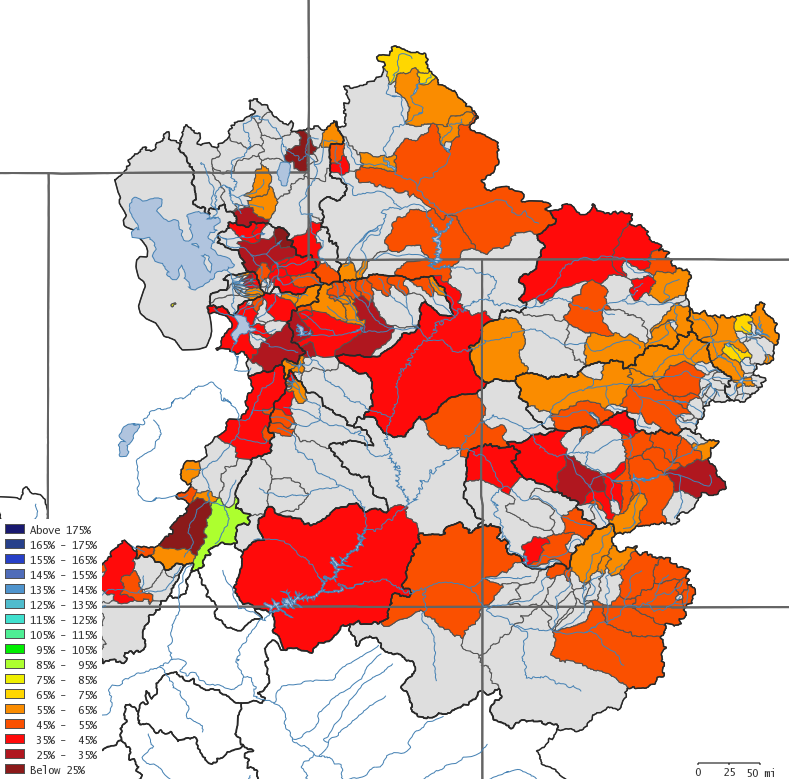
Image: River basin map for the April-July runoff forecast period. Forecasts are expressed as a percent of average.
The Little Colorado, Salt, Verde, and Gila Basins (not displayed) are forecast for less than 50% of the April-May median.
Click here for specific site water supply forecasts
Water Supply Discussion
Weather Synopsis:
A progressive weather pattern in March did not allow for a dominant feature such as a high pressure ridge
or low pressure trough to become established for an extended period of time over the CBRFC region. A mixed
bag of weather conditions was the result with brief periods of warm dry conditions followed by periods of wet
weather. The storms that did move through however were generally quick moving and weak. Although monthly average
temperatures were not abnormally warm or cold over the northern half of the CBRFC region, precipitation for
March was well below average over most of the area.
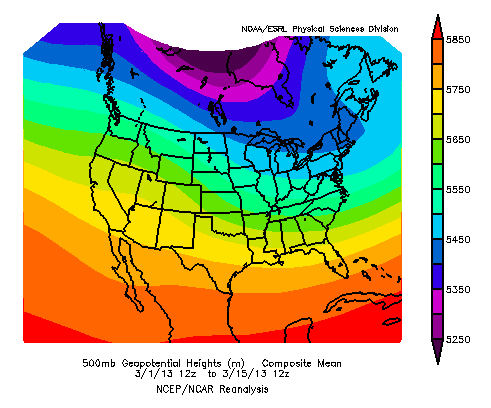

Image: Mean upper air pattern over the continental U.S. for March 2013 (first half of March left, second half right).
The weather pattern was progressive, resulting in a mix of warm dry days and wet cool days.
Precipitation and Temperature:
February was very dry and conditions did not improve in March. Precipitation in March was much below average over the
CBRFC region. The exceptions to this were the headwaters of the Colorado River near Granby, Colorado and Yampa River
Basin above Steamboat Springs, Colorado. Precipitation values for March in these areas were closer to average with a
few stations above average. A storm during March 8-10 also pushed monthly values in the Verde and Tonto Basins in
south central Arizona to near average. Elsewhere conditions were very dry, particularly in the San Juan Basin, Duchesne
Basin, Virgin Basin, and northern Great Basin. Seasonal October-March precipitation in the water supply producing areas
is generally 70-85 percent of average, however more areas continue to fall into the 50 to 70 percent of average category.
These include the San Juan Basin, Gunnison Basin, Virgin Basin, Gila Basin, and Duchesne Basin.
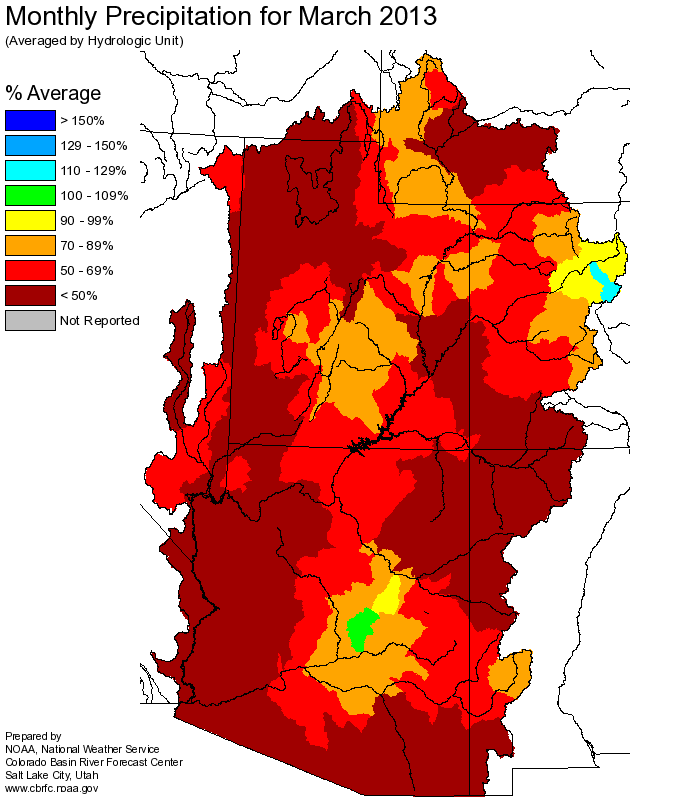

Temperatures were above average across Arizona for March but were near to slightly below average over the northern
snowmelt runoff basins. This is in stark contrast to 2012 when much above average temperatures over the northern areas
caused a rapid reduction in the snowpack and above average runoff in March.
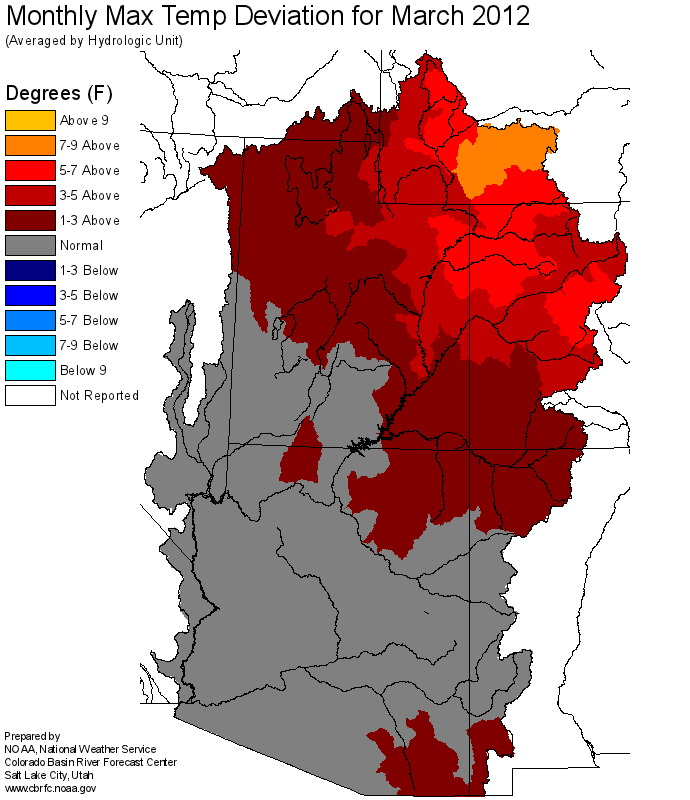
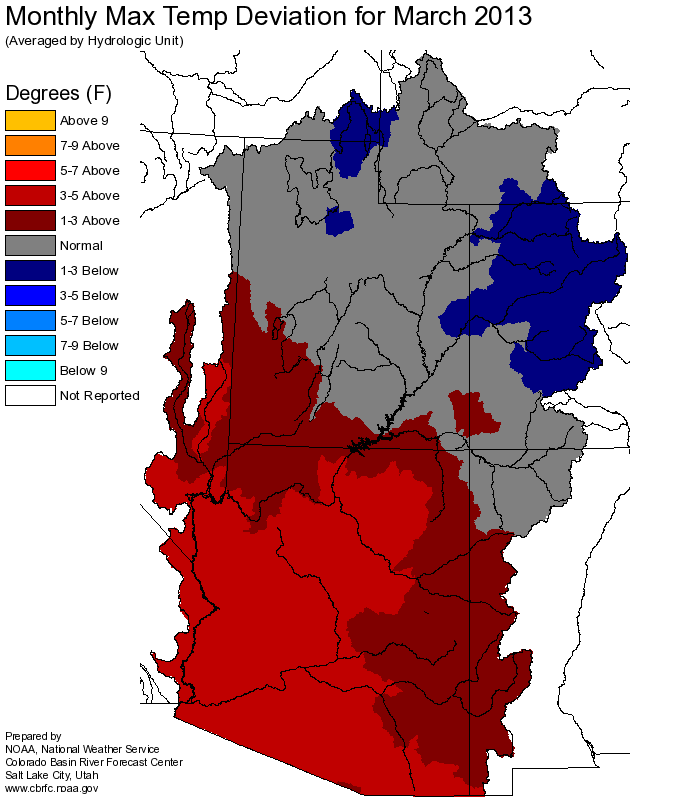
Image: March 2012 and March 2013 temperature departure from average. It was much warmer in March 2012 and resulted
in an early snow melt.
Snowpack:
Several SNOTEL sites have fallen into lower categories with respect to average due to the dry March. This is particularly
noticeable in the Great Basin, Duchesne Basin, Lower Green Basin, and San Juan Basin when comparing the maps below.
The snowpack actually gained with respect to average in the Colorado River mainstem headwaters, and changed little from
early March in the Yampa headwaters and Upper Green River Basin.
The map below is a display of Snow Water Equivalent (SWE) at SNOTEL sites as a percent of the 1981-2010 average.

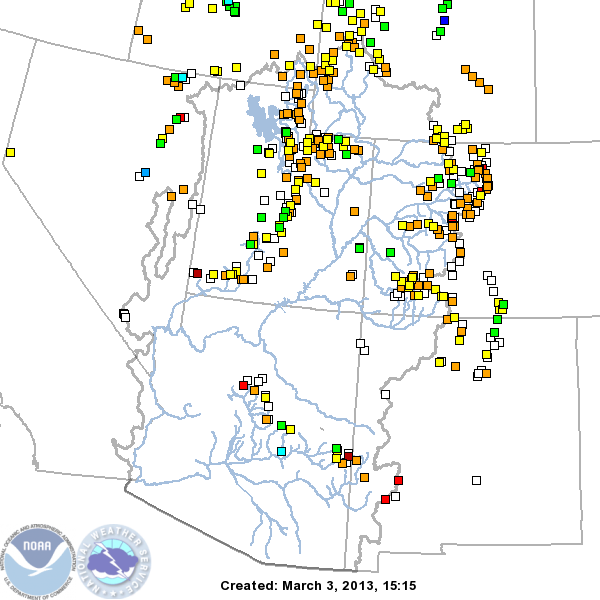
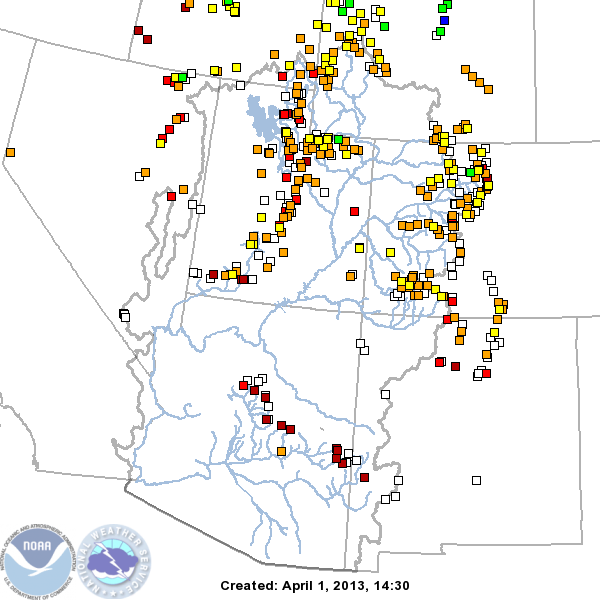
Image: CBRFC Snow Conditions Map as a percent of average for March 2013 and April 2013
Even though the snow conditions are not ideal, it is worth noting the contrast between early April of 2012 and this year.
Temperatures were favorable last month for retaining much of the snowpack into early April compared to March of 2012 when
active snow melt was underway. The differences can be seen on the maps below where many SNOTEL sites were measuring
less than 50% Snow Water Equivalent (sites in red) in early April 2012 because of melt in March.

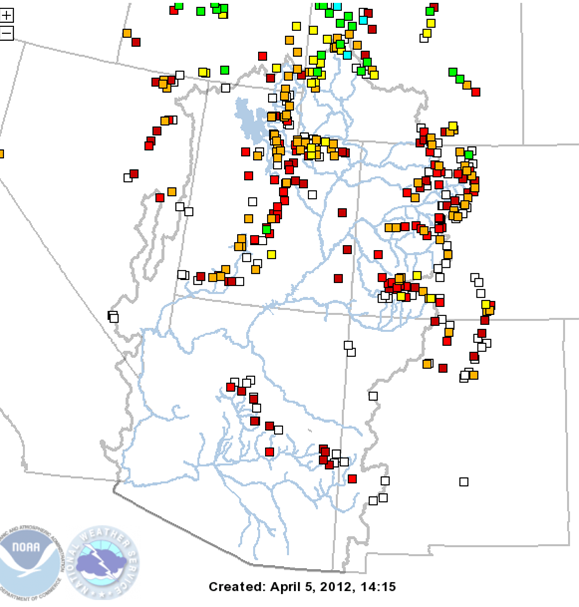

Image: CBRFC Snow Conditions Map as a percent of average for April 2012 and April 2013
Click here for river basin snow plots
Soil Moisture:
Soil moisture conditions in the higher elevation headwater areas are important entering the winter, prior to
snowfall, as it influences the efficiency of the snow melt runoff. Last fall, modeled soil moisture conditions
were below average throughout the upper and lower Colorado Basins. In northern Utah, modeled soil moisture was
closer to average in parts of the Bear, Weber, Provo, Six Creeks, and Duchesne Basins due to a late October storm
and high elevation rainfall. This is also true for some of the upper Green River Basin headwaters in Wyoming.
See the map below for a more detailed view.
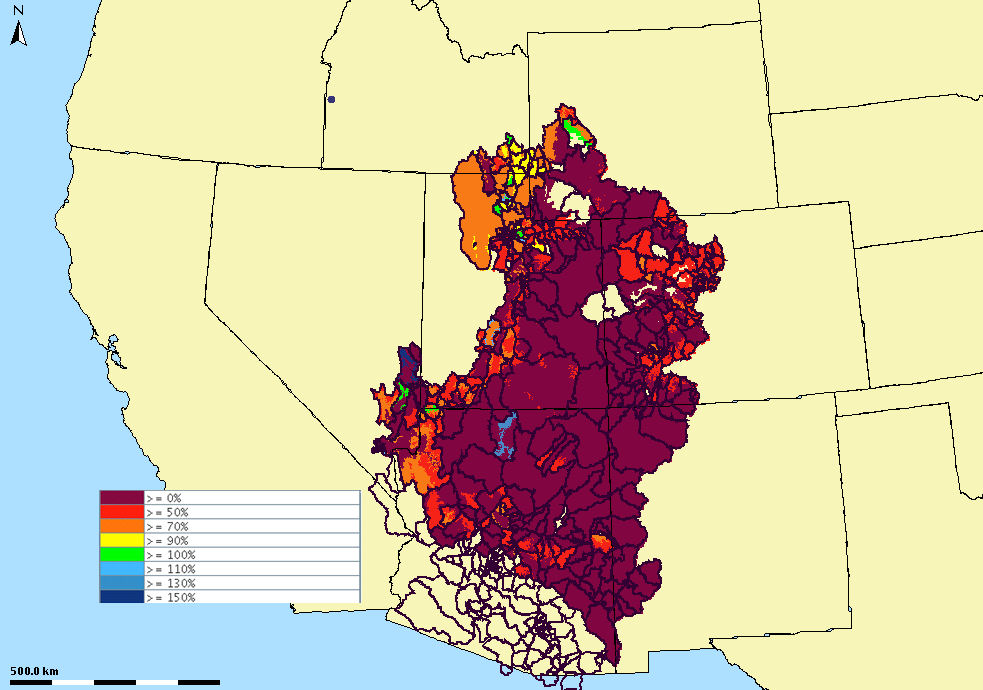
Image: Modeled soil moisture states (as a percent of average) on Dec 31 2012
Streamflow:
Precipitation in the Lower Colorado Basin resulted in streamflow conditions above the March median. The Salt River
was near 150% of median (much of that contribution from Tonto Creek), and the Verde River was near median.
Throughout the remaining CBRFC region March streamflow was much below average. These below average streamflow
conditions have existed through the fall and winter months due to the dry conditions that extend back to the
spring of 2012.
Climate Outlook:
The El Nino Southern Oscillation (ENSO) condition is considered neutral and this is expected to continue through
the northern hemisphere summer of 2013. The Climate Prediction Center indicates increased chances for below
average precipitation during the April through June period over most of CBRFC forecast area.
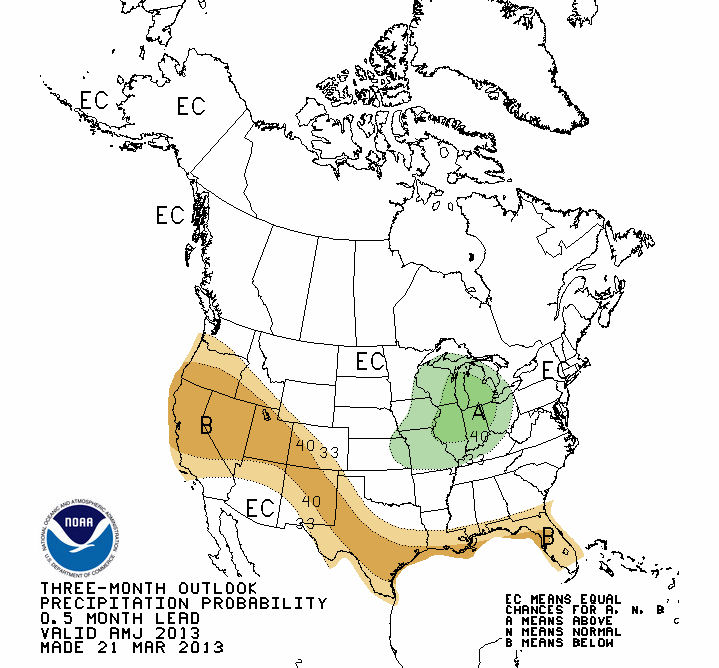
Image: Climate Prediction Center 3 month precipitation outlook
Conclusion:
Near record low runoff volumes occurred in the spring of 2012 across much of the forecast area. Very dry
conditions with much below average precipitation occurred over most of the area during the September through
November period. This has resulted in much below average modeled soil moisture conditions and observed
streamflow throughout the fall and winter months.
Mild temperatures during the fall also resulted in rainfall with initial storms instead of accumulating snow at
higher elevations. Back to back dry months this February and March has further prevented the building of the
snowpack toward average conditions. Despite some minor improvement in the snow conditions in the Colorado River
mainstem headwaters over the past month, snow conditions are much below average. Snow conditions deteriorated
further in several areas including the Great Basin, Duchesne Basin, Lower Green Basin, Virgin Basin, and San
Juan Basin.
With the average seasonal snowpack peak occurring in the April-May period at most higher elevations, the time window
for additional accumulation continues to shrink and becomes an important factor in the runoff volume forecasts.
Streamflow spring runoff volumes are forecast to be much below average across the Upper Colorado River Basin and
much below median across the Lower Colorado River Basin as of April 1st.
End Of Month Reservoir Content Tables
Green River Basin
Upper Colorado River Basin
San Juan River Basin
Great Salt Lake Basin
Sevier Basin
Lower Colorado Basin
Basin Conditons and Summary Graphics
Green River Basin
Upper Colorado River Basin
San Juan River Basin
Great Salt Lake Basin
Sevier River Basin
Lower Colorado Basin
Definitions
10% exceedance forecast: Given the current hydrometeorological conditions, i.e current snowpack, soil moisture and streamflow, the volume that has a 10% chance of being exceeded. Previously referred to as "Reasonable Maximum Forecast".
50% exceedance forecast: Given the current hydrometeorological conditions, i.e current snowpack, soil moisture and streamflow, the volume that has a 50% chance of being exceeded. Previously referred to as "Most Probable Forecast".
90% exceedance forecast: Given the current hydrometeorological conditions, i.e current snowpack, soil moisture and streamflow, the volume that has a 90% chance of being exceeded. Previously referred to as "Reasonable Minimum Forecast".
Acre-Foot (af):
The volume equal to one acre covered one foot deep (43,560 cubic feet). See kaf below.
Average:
The arithmetic mean. The sum of the values divided by the number of values. Values from 1981-2010 are used for this publication.
Categories:
Much Above Average=Greater than 130%, Above Average=111-130%, Near Average=90-110%, Below Average=70-89%, Much Below Average=Less than 70%.
CBRFC:
Colorado Basin River Forecast Center.
Forecast Period:
The period from April 1 through July 31, unless otherwise noted.
kaf:
Thousand Acre-Feet. See Acre-Foot above.
Inflow:
The volume of water that flows into a reservoir or lake.
Median:
The middle value of an ordered set of values. Half of the values are higher and half of the values are lower. When the set contains an even number of values the median is the average of the two middle numbers.
NOAA:
National Oceanic and Atomospheric Administration.
NWS:
National Weather Service.
Rounding Conventions:
| Range | | Round to |
| 0-1.99 | | 0.01 |
| 2.0-19.9 | | 0.1 |
| 20-199 | | 1.0 |
| 200-999 | | 5.0 |
| 1000+ | | 3 significant digits |
Streamflow:
The volume of water that flows past a specific stream site.
Water Year:
The 12-month period, October 1 through September 30. The water year is designated by the calendar year in which it ends. Thus, the year ending September 30, 2008, is called the "2008 water year."
Additional Information
Water supply forecasts take into consideration present hydrometeorological conditions and use
average basin temperatures and precipitation for the forecast period. As the forecast season progresses,
a greater portion of the future hydrologic and climatic uncertainty becomes known and
monthly forecasts become more accurate. For more information on the tools we use, consult
Water Supply Forecasting Tools.
Volume forecasts represent adjusted flows; that is, observed flows with upstream water use
taken into account. Adjusted flows will closely approximate natural or unimpaired flows.
However, not all upstream diversions or impoundments are measured or quantifiable. For specific
adjustments used with each forecast point, consult the
Guide to Water Supply Forecasting.
The Water Supply Outlook is issued monthly January through May by the Colorado Basin River
Forecast Center. It represents a coordinated effort between the
National Weather Service, Natural Resources Conservation Service, Bureau of Reclamation, U.S.
Geological Survey and local water district managers.
Note: Data used in this report are provisional and are subject to revision.
For more information, or to be included on the mailing list, please contact:
Colorado Basin River Forecast Center
2242 W North Temple
Salt Lake City, UT 84116
(801) 524-5130
www.cbrfc.noaa.gov














